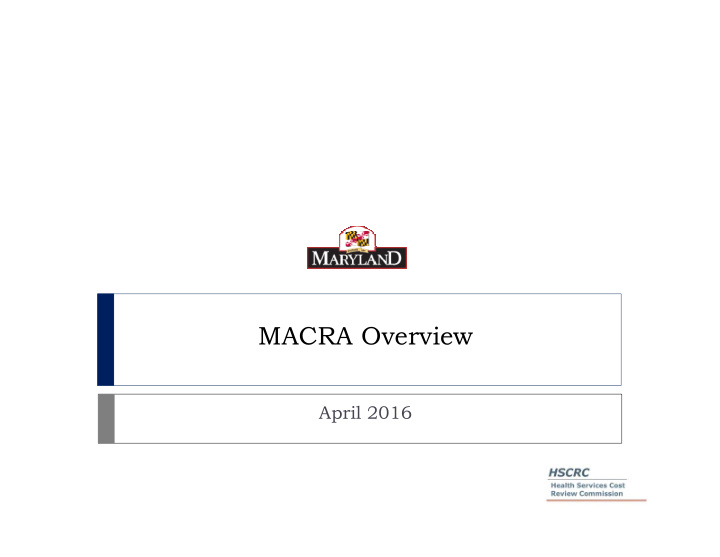



MACRA Overview April 2016
CMS is Focused on Progression from Volume-Based to Value-Based Payments Hospitals have some value-based payment via Hospital VBP , readmissions, and HAC programs Other provider groups (e.g. physicians, post-acute care) are moving to pay-for- performance, value-based purchasing 2 Source: Health Care Payment Learning & Action Network Alternative Payment Model (APM) Framework Final White Paper, 2016
3 https://www.cms.gov/Medicare/Quality-Initiatives-Patient-Assessment-Instruments/Value-Based-Programs/MACRA-MIPS-and-APMs/MACRA-LAN-PPT.pdf
Accelerating Movement via MACRA MACRA is formally known as the H.R.2 Medicare Access and CHIP Reauthorization Act of 2015 Signed into law by Obama in April 2015 MACRA Highlights Repeals use of the Sustainable Growth Rate (SGR) Formula Cut Medicare physician fees for all services if total physician spending exceeded a target, penalizing individuals who did control their costs Was volume-based- did not reward improvements in quality Replaces SGR with new quality-driven payment systems for providers ***Still many unknowns- Regs coming out this summer 4
MACRA: Provider Reimbursement Changes 2019-2025: Move to value-based payments via involvement in either of two tracks: 1) MIPS: Merit-Based Incentive 2) APMs: Alternative Payment Payment System Models • Continues traditional FFS track • Medicare providers can opt out of MIPS and receive +5% • BUT a portion of Medicare bonus in rates if a substantial provider payment at risk will portion of their revenue is gradually increase up to -9% to through APMs +9% based on their performance on quality and • Qualifying APMs definition TBD outcomes measures based on rulemaking. 2026+: All Medicare providers receive 0.25% update APM providers will receive an additional 0.5% update, thereby receiving a 0.75% update overall for Medicare services 5 Source: Summarized from Premier Medicare Payment Reform: Implications and Options for Physicians and Hospitals, 2015
Track 1: MIPS Performance Areas Quality (e.g. preventive care, safety, etc.) Resource use (e.g. Medicare spending per beneficiary) Meaningful use of EHRs Clinical practice improvement activities Care coordination Expanded access (e.g. same day appointments) Patient safety and practice assessment (e..g surgical checklists) Beneficiary engagement (e.g. use of shared decision-making) Population management APM participation Each category will have an underlying set of activities or measures Measures used for the evaluation of provider performance can be based on all payer data (not only Medicare) 6 Source: Summarized from Premier Medicare Payment Reform: Implications and Options for Physicians and Hospitals, 2015
Track 2: Alternative Payment Models (APMs) Poviders will receive +5% bonus , in addition to payments otherwise made under the APM, if they have a minimum amount of revenue at risk through an APM T o qualify for the bonus in 2019, providers may need to be in an APM in 2017 See Appendix To qualify as an eligible APM, providers must: Use certified EHR technology Meet quality measures (comparable to MIPS measures) Assume more than “nominal” financial risk Not yet sure what this means– definition TBD based on rulemaking 7 Source: Summarized from Premier Medicare Payment Reform: Implications and Options for Physicians and Hospitals, 2015
Strategic Implications for Maryland MACRA demonstrates the federal movement to two-sided risk and alternative payment models (e.g. ACO, PCMH, bundled payment, etc.) and focus on efficiency, outcomes, and financial responsibility Maryland’s next steps may include: Assess current state, identify gaps, analyze opportunities and develop roadmap Develop and implement physician partnership strategy 8 Source: Summarized from Premier Medicare Payment Reform: Implications and Options for Physicians and Hospitals, 2015
Appendix
MACRA: MIPS & APM Timeline Overview 10 Source: CMS.gov Merit-Based Incentive Payment System (MIPS) & Alternative Payment Models (APMs) website, 2015
MIPS & MACRA Eligibility 11 Source: Premier Medicare Payment Reform: Implications and Options for Physicians and Hospitals, 2015
MIPS Performance Measures 12 Source: Premier Medicare Payment Reform: Implications and Options for Physicians and Hospitals, 2015
MIPS Payment Adjustment Factors 13 Source: Premier Medicare Payment Reform: Implications and Options for Physicians and Hospitals, 2015
MIPS Payment Adjustment Factors 14 Source: Premier Medicare Payment Reform: Implications and Options for Physicians and Hospitals, 2015
APM: Provider Eligibility Required Percentage of Provider’s Revenue Under Risk-Based Payment Models Required for All Providers 2019 – 2020 25% N/A Option 1 Option 2 OR 2021– 50% 2022 50% N/A 25% 2023 75% 75% and on N/A 25% Medicare All-Payer 15 Source: The Medicare Access and CHIP Reauthorization Act of 2015; Advisory Board analysis.
Recommend
More recommend